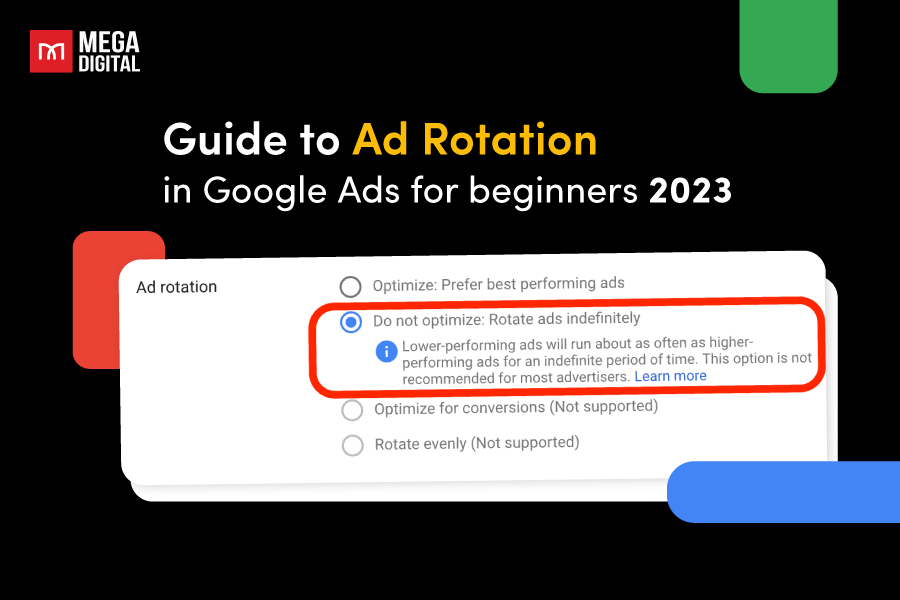If you want to expand your reach and connect with more potential target audiences through your Twitter ad campaigns, you’ve come to the right place! In this blog post, I will explain all X/Twitter ads targeting options available, as well as present a list of all effective strategies that help you leverage these tools.
What is X/Twitter Ads Targeting?
X/Twitter Ads targeting is a feature that allows advertisers to reach specific audiences on X/Twitter based on their interests, demographics, and behaviors. The main goal of X/Twitter Ads targeting is to get your ads in front of relevant users when it matters the most.
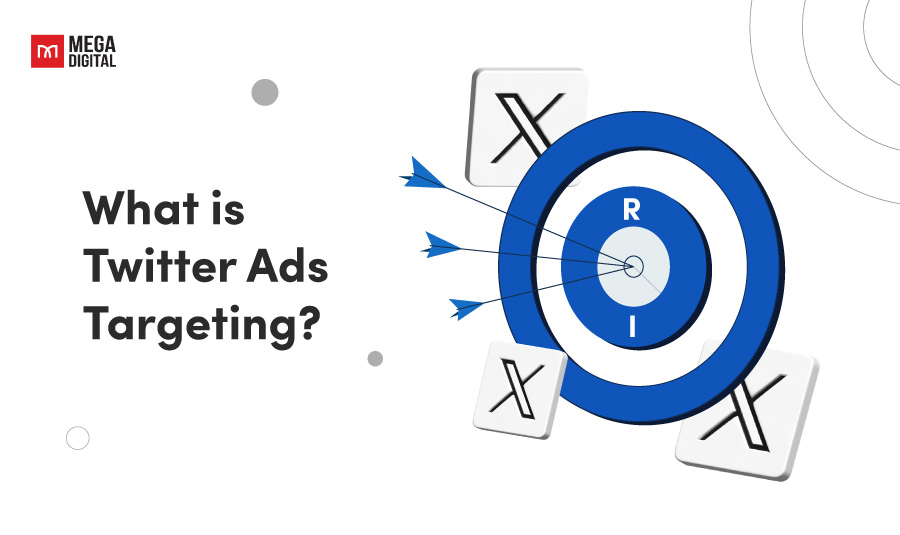
How Does Twitter Ads Targeting Work?
How X/Twitter ads targeting within an ad campaign operates is pretty much the same as other advertising platforms do. By using a variety of signals, such as user activity, profile information, or engagement patterns, X/Twitter identifies users who match the profile of your target audience and serves your ads to them.
One of the factors influencing X/Twitter ads targeting is real-time targeting, which allows advertisers to tap into live conversations and trending topics. This approach helps brands engage with users who are actively discussing relevant subjects, making their ads more timely and contextually appropriate.
Another key element affecting X/Twitter ads targeting is keyword targeting. Advertisers can reach users based on specific words or hashtags they’ve recently tweeted or engaged with. This level of specificity is particularly powerful for campaigns aiming to capitalize on viral content or to connect with audiences during high-impact events.
All X/Twitter Ads Targeting Options
Here is a summary of all of the X/Twitter ads targeting options I will cover in this post.
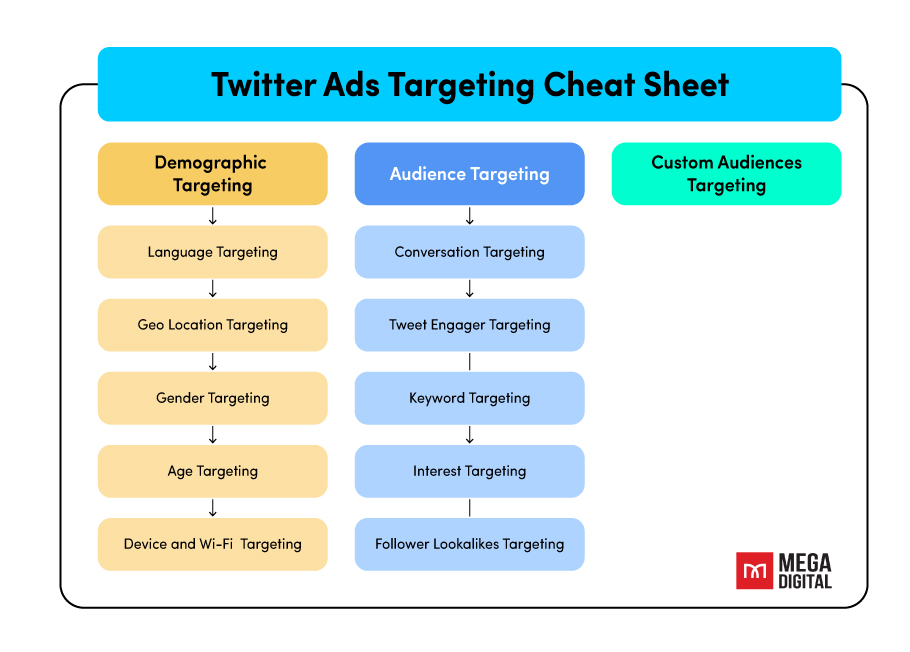
1. Demographic Targeting
X/Twitter ads demographic targeting allows advertisers to refine their audience based on specific demographic information such as gender, age, and location.
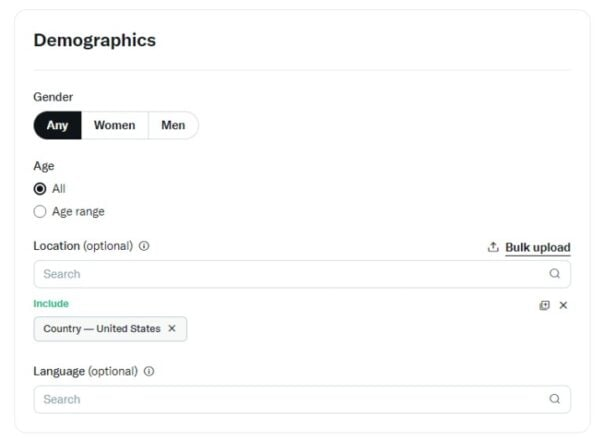
Think of each demographic targeting option as a filter. When you apply multiple filters, let’s call them Filter 1, Filter 2, and Filter 3, your ad will only be shown to users who pass through all three filters. In other words, a user must meet the criteria of Filter 1 AND Filter 2 AND Filter 3 to see your ad. This means that your ad will be targeted more precisely, but it will also reach a smaller, more specific group of X/Twitter users.
Let’s find out all the X/Twitter targeting options that fall under demographic targeting!
Language Targeting
Language targeting allows you to reach people who understand a specific language. Advertisers can use this targeting option to promote their products to people based on the languages the users are using.
Currently, X/Twitter only supports 46 languages. If you choose more than one language, you will reach users who understand at least one of the selected languages.
Geo Location Targeting
Reach people residing in specific countries, regions, metros, cities, postal codes, or a radius around a location.
Not all countries have specific regions available yet, but you can always use those regions that are nearest to your target area. Similarly, you can only reach countries where X/Twitter is accessible.

Gender Targeting
Target males, females, or all genders entered on their profiles, based on your campaign objectives. X/Twitter ads use the gender provided by people in their profiles, and extend that data to other people based on factors of account likeness to determine the gender of people who haven’t manually entered their preferred gender.
Age Targeting
You can specify the age range of users you want to target with your ads. X/Twitter has a number of age buckets that you can target with your ads. Whether you’re aiming for the young and hip crowd or the seasoned veterans, X/Twitter allows you to narrow down your audience based on age.
Device and Wi-Fi Targeting
Layer additional targeting based on phone model, device type, carrier, and Wi-Fi connection. This helps optimize your ads for specific devices and network conditions.

This advanced targeting option enables advertisers to target users based on their phone model or Wi-Fi-connected devices.
2. Audience Targeting
X/Twitter ads audience targeting enables advertisers to reach specific groups of users based on a variety of factors such as their interests, behaviors, and conversations.
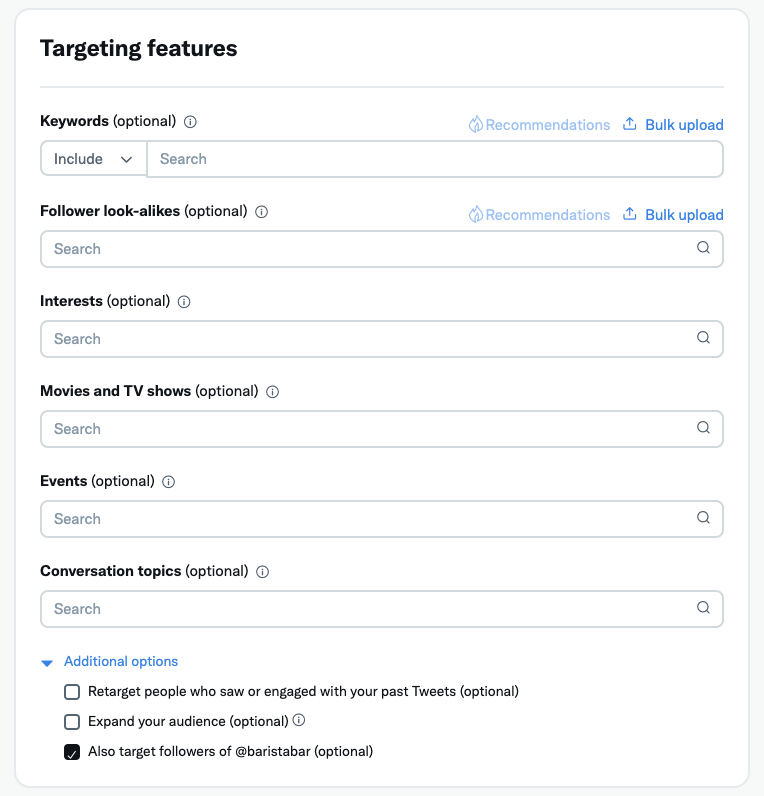
Unlike demographic targeting, when using audience targeting options for X/Twitter ads, each type of targeting you select acts like an additional layer that broadens your potential audience. This approach allows you to reach a diverse range of users who may have different interests or behaviors but still fall within the scope of your campaign’s objectives.
Let’s explore all X/Twitter targeting options available within audience targeting!
Conversation Targeting
Conversation targeting allows you to tailor your ads based on the content of users’ everyday conversations. This can be useful for engaging with specific topics or trends.
With conversation targeting, your business can reach people based on conversations over ten thousand topics across 25+ categories.
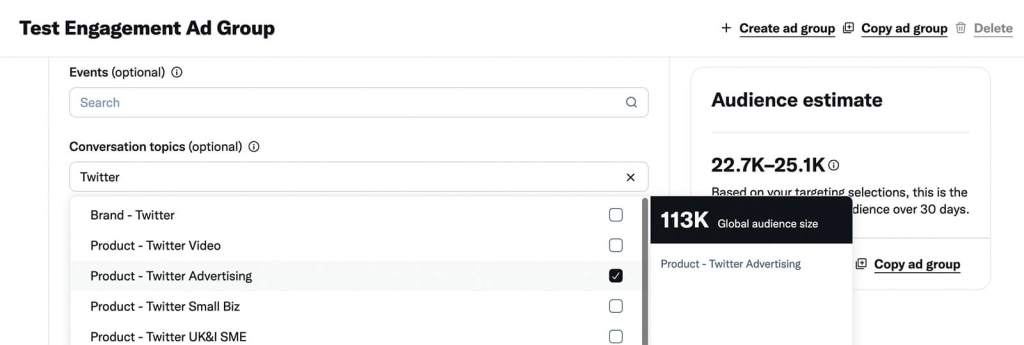
Conversation targeting now includes the following audience features:
- Event targeting: Event targeting enables brands to reach people discussing major online and offline events. With this option, you can target events up to 2 weeks before they begin, and for 3 weeks after they are over.
- Movies and TV targeting: Allows advertisers to reach people who tweet about or engage in conversation around numerous movies & TV shows.
Tweet Engager Targeting
This targeting option focuses on users who have seen or engaged with an advertiser’s promoted or organic tweets, such as liking, retweeting, or replying. This lets you reach a warm audience already familiar with your brand and potentially more receptive to your ads.
Keyword Targeting
Keyword targeting allows advertisers to reach users based on specific keywords in their search queries, recent tweets, and tweets they’ve engaged with. It is designed to connect you with the most relevant audience, driving engagement and increasing conversions.
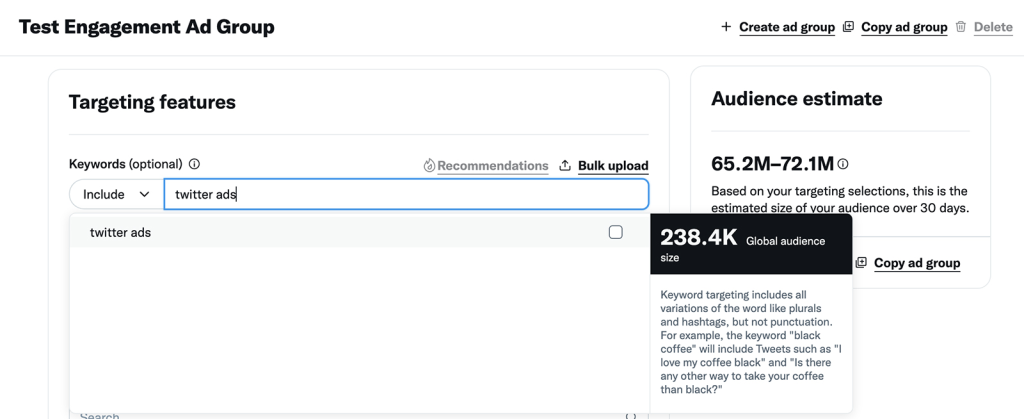
Interest Targeting
Interesting targeting allows advertisers to connect with users based on their specific interests, hobbies, and preferences. This targeting feature is designed to help you reach individuals who are more likely to be interested in your products or services by aligning your ads with their expressed or inferred interests.

Follower Lookalikes Targeting
Follower lookalikes targeting allows you to target people with similar interests or behave similarly to an account’s followers. This expands your reach beyond your current followers. An example is targeting the @TechCrunch account to reach people likely to be interested in tech news focused on founders and startup teams.
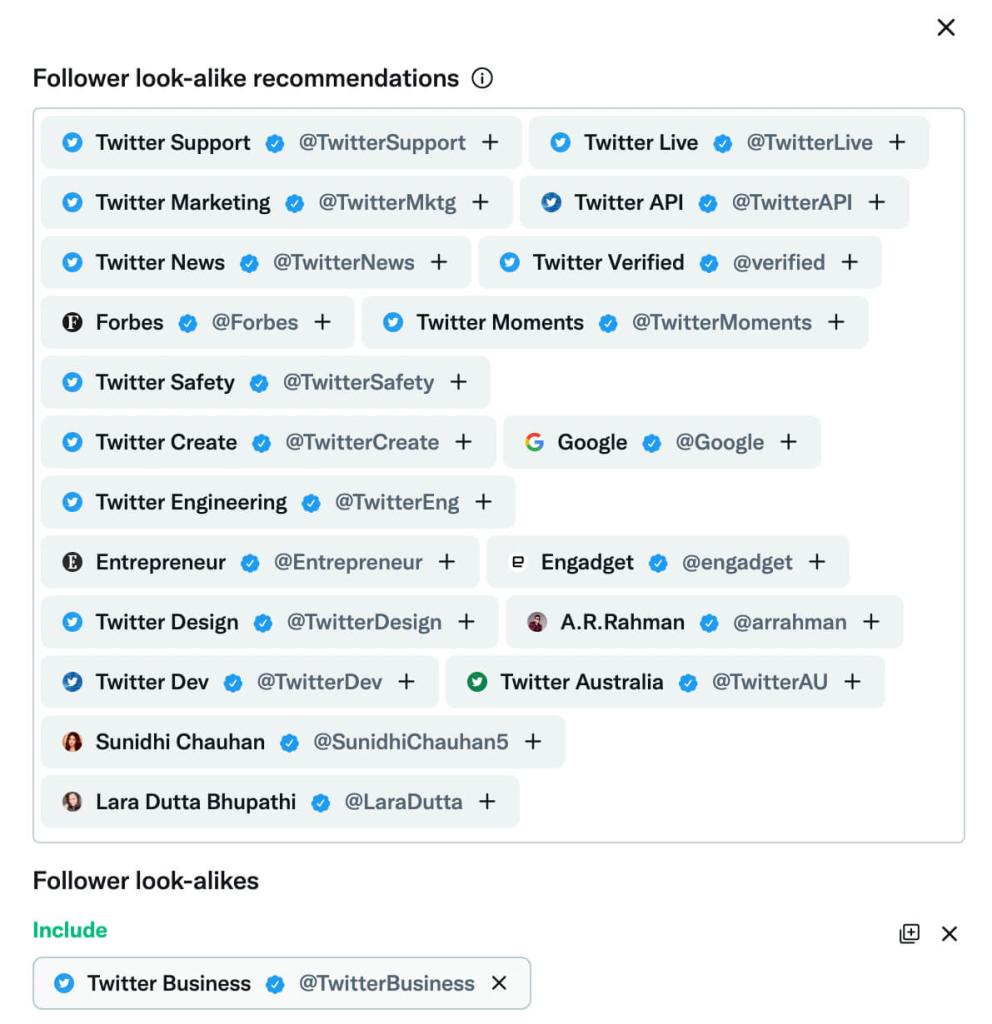
3. Custom Audiences Targeting
Custom Audience targeting allows advertisers to create specific user groups for retargeting, exclusion, or expansion.
How to create custom audiences:
- First, visit the Audiences manager page via the “Tools” menu.

- On the Audiences page, click the “Create audience” button in the top right corner, then select the type of audience that you want like to create.
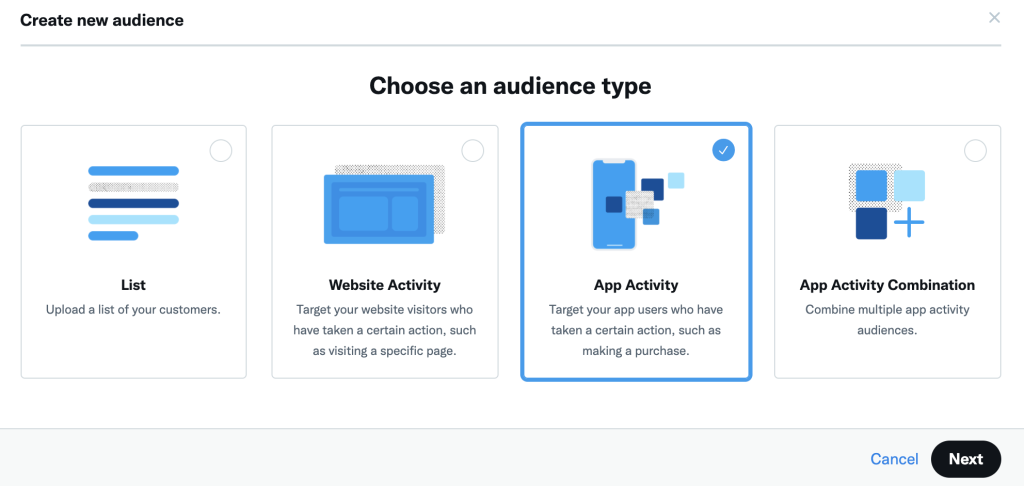
Now I will explain various audience types you can create:
List custom audiences
Advertisers can upload a file containing first-party or third-party customer data. Twitter then matches this data with the @handles of active users on the platform.
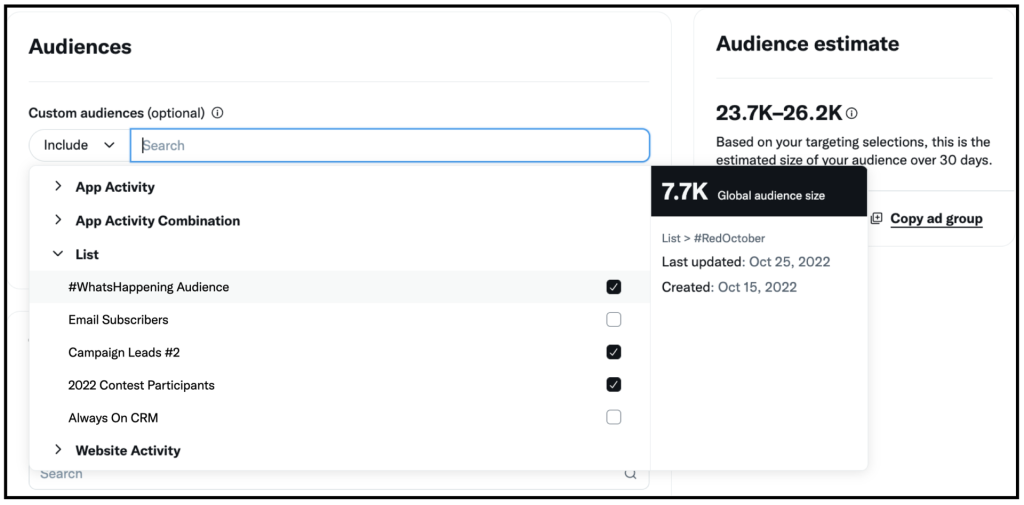
List custom audiences is perfect for:
- Retargeting: Show ads to existing customers to encourage repeat purchases.
- Exclusion: Exclude current customers from seeing acquisition-focused ads.
- Expansion: Create lookalike audiences based on your customer list to find new potential customers.
Website activity custom audiences
This audience type is generated by using X/Twitter’s Website Tag to track people who have visited your website or taken specific actions there with active users on X/Twitter. To begin, ensure that you have X/Twitter Pixel or Conversion API installed on your site or are using an accepted tag manager partner.
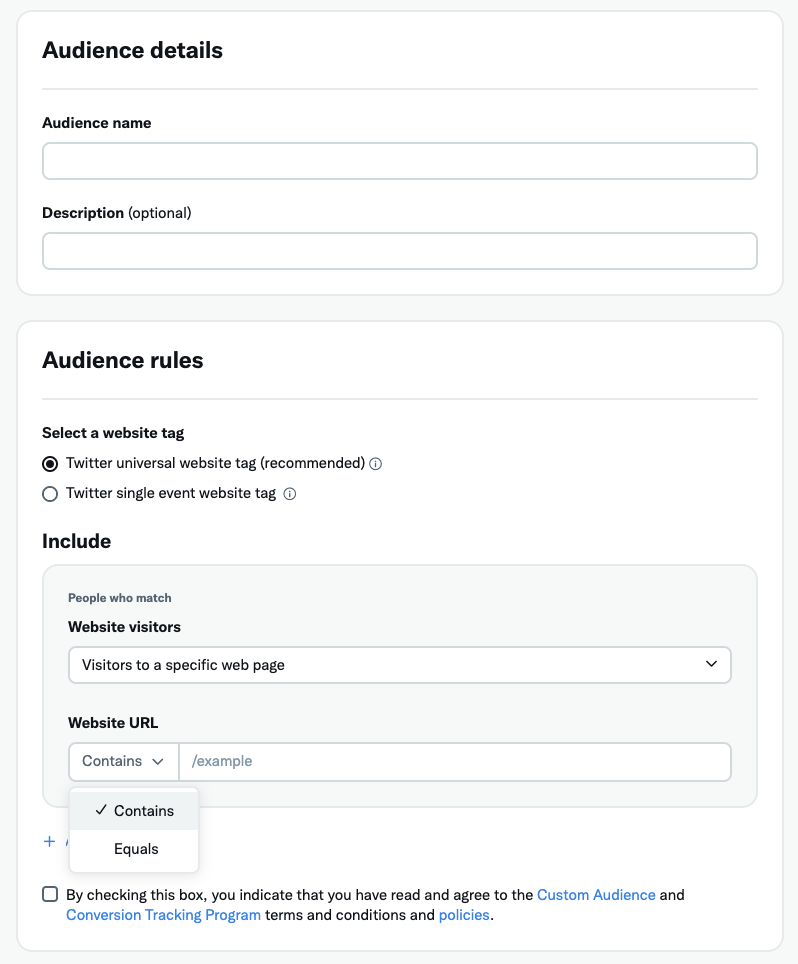
Website activity custom audiences can be useful for:
- Retargeting: Target users who visited specific product pages but did not complete a purchase.
- Exclusion: Exclude users who have already completed a purchase from seeing further promotional ads.
- Conversion optimization: Focus on users who have shown intent to purchase to drive conversions.
App activity custom audiences
Based on mobile app events provided by a mobile tracking partner, X/Twitter targets people who downloaded your app or took specific actions within it.

App activity custom audiences best suited to the following purposes:
- Single event-based targeting: Engage users who have downloaded your app but haven’t used it recently.
- Upsell/cross-sell: Promote additional products or services to users who have made previous in-app purchases.
App activity combination custom audiences
App activity combination custom audiences allow advertisers to target a more precise subset of users by combining multiple app activity audiences. This involves layering multiple criteria using Boolean logic (AND/OR) to create highly specific audience segments.
How to Set Up Targeting on X/Twitter?
Setting up targeting for your X/Twitter Ads is crucial for reaching the right audience and maximizing the effectiveness of your campaign. Here are the steps to set up targeting on X/Twitter:
Step 1: Choose your campaign objective
Start by selecting an objective that aligns with your goals, such as awareness, engagement, or conversions. After that, decide on a X/Twitter ads type that aligns with your campaign objective.

Step 2: Select your targeting criteria
Next, you need to select your targeting criteria. X/Twitter offers a variety of targeting options, including interest targeting, keyword targeting, and behavior targeting. You can fill in information for each tarrgeting option:
- Demographic tatrgeting: Define your audience based on age, gender, location, and language.
- Audience targeting: Reach specific groups of users based on a variety of factors such as their interests, behaviors, and conversations.
If you want to leverage your off-platform customer information to create unique audience segments, you can create custom audiences using your own data, such as email lists, website visitors, or mobile app users.
Step 3: Exclude irrelevant audiences
Use exclusion targeting to remove users who are not relevant to your campaign, such as existing customers in acquisition campaigns.
Step 4: Turn on Automated targeting
Finally, consider turning on Automated Targeting. This feature uses Twitter’s machine learning algorithms to continuously optimize your targeting based on real-time data and ad performance. Automated targeting can save you time and help you reach a wider audience.
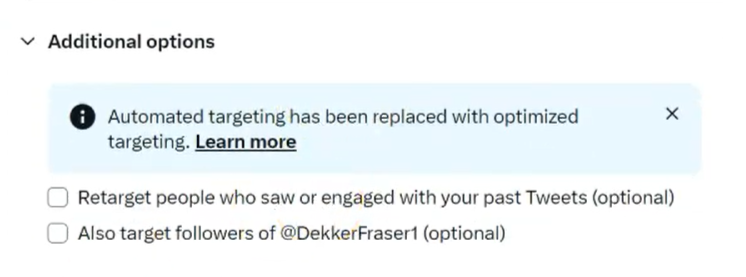
5 Tips for Using X/Twitter Ads Targeting Effectively
To use X/Twitter Ads targeting effectively, consider integrating the following five tips into your advertising approach:

1. Utilize Keyword Targeting for Real-Time Engagement
X/Twitter’s unique keyword targeting allows you to reach users based on the words and phrases they use in their tweets. This is particularly effective for engaging with users who are discussing current events, trending topics, or specific themes related to your brand. To make the most of this feature:
- Identify relevant keywords and hashtags related to your industry or campaign.
- Monitor trending topics and adjust your keywords accordingly.
- Combine keywords with negative keywords to refine your targeting and avoid irrelevant mentions.
2. Leverage Follower Targeting to Tap into Existing Audiences
Follower targeting enables you to reach users who follow specific accounts. This can include competitors, industry influencers, or brands similar to yours. By doing so, you can:
- Target a highly engaged audience already interested in similar content.
- Build brand awareness among users who follow influential accounts in your niche.
- Craft ad creatives that resonate with the interests and preferences of these followers.
3. Use Tailored Audiences for Precision Targeting
Tailored Audiences allow you to create custom segments based on your own data, such as email lists, website visitors, or app users. This can significantly enhance the relevance of your ads. To effectively use Tailored Audiences:
- Upload customer lists to retarget existing customers or exclude them from acquisition campaigns.
- Set up the X/Twitter Pixel on your website to retarget visitors based on their on-site behavior.
- Integrate with mobile tracking partners to target users based on in-app activities.
4. Take Advantage of Event Targeting for Time-Sensitive Campaigns
Event targeting is a powerful tool on X/Twitter, allowing you to engage with users who are actively discussing live events. Whether it’s a major sports event, a TV show premiere, or a conference, event targeting can help you:
- Connect with a highly engaged audience in real-time.
- Tailor your messaging to the context of the event for greater relevance.
- Increase the visibility of your ads by aligning them with popular and timely conversations.
5. Continuously Optimize Through Analytics and Insights
X/Twitter Ads provides robust analytics and reporting tools to help you monitor the performance of your campaigns. Use these insights to:
- Track key metrics such as impressions, engagement rates, and conversions.
- Identify which targeting options are delivering the best results.
- Adjust your targeting parameters and ad creatives based on data-driven insights to improve campaign performance.
Final words
In conclusion, X/Twitter ads targeting can significantly amplify your brand’s voice and engagement, bringing your business closer to your target audience. By leveraging all the targeting options available, you can craft campaigns that resonate deeply with your audience, driving not just clicks, but meaningful interactions.









